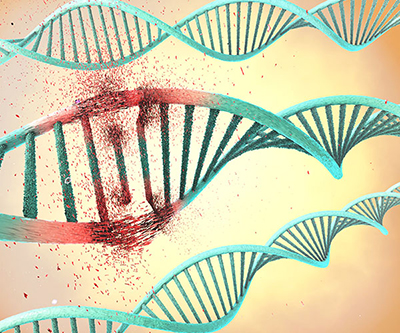
Artistic representation of DNA damage.
Credit: Stock image
The integrity of DNA—the repository of genetic information—is essential to life. DNA in living cells is continuously subject to damage from interactions with various chemicals and environmental factors. Although all organisms have elaborate processes to rapidly repair DNA damage, some damage may persist and stall the process of DNA replication during cell division, which can harm the integrity of the genome. To avoid this, cells use specialized Y-family polymerases to copy DNA containing unrepaired damage that would otherwise block the cell’s normal replicase. This affords the cell additional time to repair the damage and to complete the cycle of cell division.
Y-family polymerases are divided into six distinct subfamilies, which are found in various combinations across the different domains of life. For example, higher eukaryotes such as humans and mice possess genes for four Y-family polymerases, whereas the yeast Saccharomyces cerevisiae only possesses genes for two.
Is there logic in the seemingly random distribution of Y-family polymerases? The Woodgate Lab sought to answer this question by characterizing the Y-family polymerases from the fungus Thermomyces lanuginosus and comparing their properties to those from other species.
In contrast to S. cerevisiae and other fungal relatives, T. lanuginosus possesses all four eukaryotic Y-family subfamilies. Previously, researchers had thought that one of these subfamilies—polι—was limited to higher eukaryotes. However, the NICHD scientists found that T. lanuginosus polι exhibited similar functions to its human counterpart, suggesting that this polymerase may play a critical role in both higher and lower eukaryotes.
Further studies of these polymerases would help clarify how their presence or absence could provide advantages in the face of different environmental stressors.
 BACK TO TOP
BACK TO TOP